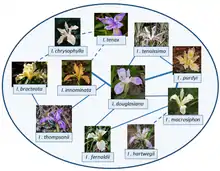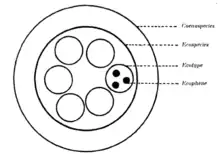Syngameon refers to groups of taxa that frequently engage in natural hybridization and lack strong reproductive barriers that prevent interbreeding.[1][2] Syngameons are more common in plants than animals, with approximately 25% of plant species and 10% of animal species producing natural hybrids.[3] The most well known syngameons include irises of the California Pacific Coast and white oaks of the Eastern United States.[2][4] Hybridization within a syngameon is typically not equally distributed among species and few species often dominate patterns of hybridization.[3]

The term syngameon comes from the root word syngamy coined by Edward Bagnall Poulton to define groups that freely interbreed.[5] He also coined the word asyngamy referring to groups that do not freely interbreed (with the substantive noun forms Syngamy and Asyngamy).[5] The term syngameon was first used by Johannes Paulus Lotsy, who used it to describe a habitually interbreeding community that was reproductively isolated from other habitually interbreeding communities.[6] Syngameon was used interchangeably with the term species to describe groups of closely related individuals that interbreed to varying degrees.[5] A more specific definition of syngameon has been given to groups of taxa that frequently engage in natural hybridization and lack strong morphological differences that could be used to define them.[1][2] Taxa in syngameons may have separate species names, but evolutionary biologists often suggest they should be treated as a single species.[1] Variation among species within a syngameon can be due to a number of factors related to their biogeography, ecology, phylogeny, reproductive biology, and genetics.[3]

Coenospecies
The terms coenospecies and syngameons are both used to describe clusters of lineages that are morphologically distinct and lack strong isolation mechanisms.[1] Coenospecies, first coined by Göte Turesson in 1922,[7] refers to the total sum of possible combinations in a genotype compound, which includes hybridization that occurs both naturally and artificially.[7] Coenospecies is often used to describe lineages that can be crossed under cultivation and only a few species pairs are found to form natural hybrids, whereas syngameons refer to species where extensive evidence of natural hybridization occurs.[8][2] In this sense, definitions of syngameon and coenospecies correspond to the two different definitions of the Biological Species Concept proposed by Ernst Mayr; syngameon is consistent with “actually” interbreeding species, while coenospecies is consistent with “actually or potentially” interbreeding species.[1] The term ecospecies is considered a subdivision of coenospecies that refers to the genotypes within a coenospecies that hybridize and produce viable, fertile offspring.[7]
References
- 1 2 3 4 5 6 Cruzan, Mitchell B. (2018). Evolutionary biology a plant perspective. Oxford University Press. ISBN 978-0-19-088268-6. OCLC 1076045196.
- 1 2 3 4 Grant, Verne (2 March 1981). Plant Speciation. Columbia University Press. doi:10.7312/gran92318. ISBN 978-0-231-88811-0.
- 1 2 3 Boecklen, William J. (1 November 2017). "Topology of syngameons". Ecology and Evolution. 7 (24): 10486–10491. doi:10.1002/ece3.3507. ISSN 2045-7758. PMC 5743628. PMID 29299231.
- ↑ Lenz, Lee (1959). "Hybridization and Speciation in the Pacific Coast Irises". Aliso. 4 (2): 237–309. doi:10.5642/aliso.19590402.03. ISSN 2327-2929.
- 1 2 3 4 Wilkins, John S. (2009). "The Species Problem Arises". Species: A History of the Idea (1 ed.). University of California Press. pp. 165–180. ISBN 978-0-520-26085-6. JSTOR 10.1525/j.ctt1pp7qd.11.
- ↑ Lotsy, J. P. (9 December 1925). "Species or linneon". Genetica. 7 (5–6): 487–506. doi:10.1007/bf01676287. ISSN 0016-6707. S2CID 36998166.
- 1 2 3 Turesson, Göte (April 1922). "The Species and the Variety as Ecological Units". Hereditas. 3 (1): 100–113. doi:10.1111/j.1601-5223.1922.tb02727.x. ISSN 0018-0661.
- ↑ Stebbins, G. Ledyard (2 March 1950). Variation and Evolution in Plants. Columbia University Press. doi:10.7312/steb94536. ISBN 978-0-231-89916-1.